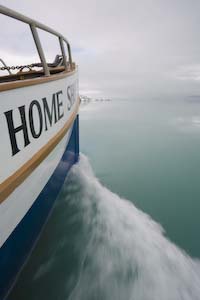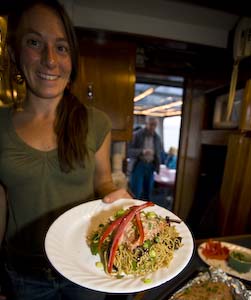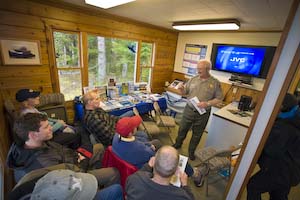Aboard the kayak mothership Home Shore, we paddle the kayaker must-do Glacier Bay National Park in Southeast Alaska for the tidewater glaciers, bears, whales and birds.

May, 2008. Glacier Bay National Park, SE Alaska. The morning of our departure from Sitka aboard kayak mothership Home Shore (Alaska on the Home Shore), Captain Jim Kyle announced that the swell height on the outside was 27 feet; in town, a driving rain pounded fresh spring flowers, and forced even the town’s numerous ravens to huddle under a ship canopy. Our destination was Glacier Bay, and we would take the longer, less exposed, inside route—with one consolation. The inside route was good for catching crab, and the second morning we scored fifteen—ten of them keepers—that kept us satiated with crab dinners, crab quiche and crab omelets ad infinitum.
Glacier Bay is a sea kayaking must do—certainly one for the bucket list—and a fascinating laboratory of glaciation and plant secession. Captain George Vancouver found an ice-choked Icy Strait when he sailed here in 1794. To the north was a ten-mile wide wall of 400 ft high ice—the entrance to Glacier Bay. By the time John Muir arrived in 1879, the glaciers had retreated 48 miles. Plant secession, sea mammals, birds and bears followed the wake of the retreating ice.

Our first paddle in Glacier Bay was Hugh Miller Inlet under threatening skies. We got glimpses of Humpback Whale and heard and saw huge numbers of sea ducks and kittiwakes. I love SE Alaska, especially Glacier Bay, in May: Migrating ducks and phalaropes in huge rafts; the cacophony of kittiwakes and long-tailed duck; the calls of thrushes and warblers on the shore. We saw two yellow-billed loons as we entered Blue Mouse Cove where we anchored for the night.

The sun finally broke out the next day as we motored into John Hopkins Inlet—a visual panoply with aquamarine waters, a slurpy of sea ice, jagged peaks with snow from tideline to summit and the multi-tiered John Hopkins glacier at its head. We launched kayaks and paddled on a dazzling sea. Our sharp-eyed kayak guide spotted two brown bear on the shore—a sow with a big third-year cub—lazing on the rocks in the sun.
We had a couple of other fine paddles, also in sun, in the following days. We motored slowly into Berg Bay on a high tide, a place where the shallow entrance dries out on the lowest tides. We could clearly see the bottom as we entered. Berg was full of sea otters (and no crab!). We paddled the south lagoon, which proved abundant in wildlife: river otter, three black bear, many birds including a Whimbrel flock, Varied Thrush foraging on the beach and the lovely song of the Swainson’s and Varied Thrush issuing from the woods. We left Berg on the high tide near 10pm, and crossed Glacier Bay under a lovely full moon.
On our paddle through the Beardsley Islands the next day, we discovered both Brown and Black bear as we meandered toward Park headquarters at Bartlett Cove. In the Beardsleys the land is rebounding an inch or two a year, forcing us to portage kayaks where the charts showed what looked to be an easy passage. Year by year, Glacier Bay is an evolving place.











